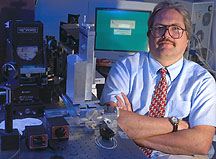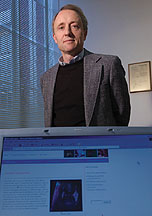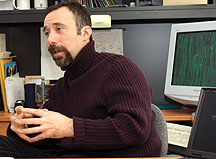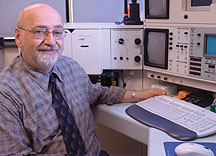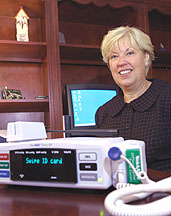![[NEWS AND FACTS BANNER]](/URClipArt/news/titleNewsFactswide.jpg) |
||||||||||||||||

|
||||||||||||||||
FeaturesTechnology TransferWith increasing success, the University is learning to “capture the value” of discoveries as researchers move into new roles as inventors, patent holders, and business founders. By Jayne DenkerWhat if there were a way to overcome the limitations of eyesight so that even someone with 20/20 vision could see better? That was a question needling David Williams, the Allyn Professor of Medical Optics and director of the Center for Visual Science, several years ago. Like a good academic researcher, the professor of brain and cognitive sciences set off to study the problem, and he discovered that designers of astronomical telescopes had developed a system that sharpens images by using mirrors to correct for aberrations created by the atmosphere.
More than a decade later, Williams has developed a suite of technology based on such “adaptive optics” that shows dramatic promise in improving human eyesight. But as the researcher delved further into the problem, he realized that he would face dollars-and-cents questions a bit outside his expertise. In other words, real people might be interested in paying real money for such technology. “When you’re completely immersed in the academic culture, it’s difficult to think in a business frame of mind,” Williams says. For help in negotiating his newfound role as inventor, Williams turned to the University’s Office of Technology Transfer, founded in 1997 to help systematize Rochester’s efforts to identify scientific, scholarly, and academic research that might have potential in commercial settings. The office is instrumental in establishing products and technology as revenue sources, especially helping researchers patent their discoveries. The office also assists in conducting market research and in helping those researchers who choose to start their own companies make an easier transition, as well as handling any patent infringements that may occur. In Williams’s case, the office facilitated a collaboration between Williams, the University, and Rochester eyecare giant Bausch & Lomb, a partnership that is fostering several trials of new techniques based on Williams’s original work. The result, researchers hope, may be “super-vision,” enhanced eyesight of a type unknown today. The collaboration is one example of a growing trend at Rochester and across the country to better manage—and, it is hoped, reap the financial benefits created by—the dynamic innovation that universities are known for. But it’s also an example of some of the tension—academia versus business—that such partnerships sometimes face. “Many of my colleagues have a disrespect for the business model and see doing something for money as a negative,” Williams says. “Many pockets of that way of thinking persist in the University.” Pat Harsche, president of the nonprofit Association of University Technology Managers (AUTM), a group made up of more than 3,200 technology managers and business executives, as well as approximately 300 universities and research institutions involved with technology transfer, says the notion is about 20 to 25 years old at universities. “It began with Stanford and MIT, the granddaddies, and really took off with biotechnology,” she says. “For the first time, there were more inventions making the transition from lab to use by the general public in a relatively short period of time.” Since 1997, Rochester has seen a dramatic increase in revenue, too—more than $42 million in 2002, which was more than 10 times the amount just four years ago. In 2001, a second office was set up to handle technology developed at the Medical Center, which has seen an 83 percent increase in disclosures since 2002. Charles Phelps, University Provost, says technology transfer adds a new dimension to the life of the University but does not replace the central missions of teaching and research. “The heart of this University—and the activity that makes Rochester such a vital place—is the pursuit of research and discovery for their own sake,” says Phelps. “And we would never want to lose the excitement that comes from following an idea wherever it leads. “But we should take advantage of the potential, where appropriate, that tech transfer offers faculty, the University, and the communities we serve,” he says. “We get tech transfer people into the departments and labs to talk about the opportunities to commercialize their work, and sometimes researchers think, ‘I can do that with my stuff.’” Mark Coburn, director of the University tech transfer office, says that until recently, most professors were judged on how often their research was published in prestigious journals, not whether their products were licensed. “It was thought a connection with industry ‘tainted’ research,” he says. “If it were sponsored by industry, you just didn’t publish that research.” In the past decade, businesses have started to view universities as sources of new products and ideas, especially as industries have cut back on their research and development while universities have not, Coburn says. Technology transfer offices have become the link between academia and industry. A related initiative that plays an important role in the Rochester’s technology transfer efforts is the Center for Electronic Imaging Systems, a state-funded consortium of New York academic institutions based at the University. The center supports collaboration between academic researchers like Williams and industrial counterparts, focusing on electronic imaging systems and microelectronics design. “Our job is to leverage academic research to transfer technologies to the industrial base so as to promote local and statewide economic development,” says center director Eby Friedman. “We are the front end of the tech transfer engine that drives economic growth.” Marjorie Hunter, director of the Medical Center’s technology transfer office, says her office pursues intellectual property protection for between 35 and 45 percent of all disclosures, and approximately one third of those end up being licensed. “Putting more emphasis on technology transfer is key,” says Hunter. “If we have more resources, we’re able to handle inquiries more rapidly and devote more time for ongoing dealings with investigators. Mostly, we’re making people aware that we’re there.” With that awareness comes new challenges: For researchers with marketable ideas, one challenge is to determine whether to continue to focus on teaching and research only, teach and do research while marketing their inventions, or strike out on their own to devote their entire attention to start-up companies. It’s an issue the University is working toward solving by coming up with more flexible options, Phelps says. “If you simply say, ‘You can’t have a separate company and teach at the same time,’ we’d have people leaving the University in droves,” he notes. “We’re trying to find ways where people can stay at the University and still carry out these activities.” Options include taking a part-time leave that lets faculty members continue to work at the University while starting their new businesses.
Kevin Parker, dean of the School of Engineering and Applied Sciences, chose to run his own business while he continued to teach, and the tech transfer office helped make the change easier, he says. Parker and former graduate student Theophano Mitsa ’91 (PhD) are responsible for one of the most widely licensed University inventions, the “Blue Noise Mask.” Developed in the late 1980s because engineers needed a better way to print medical images, the Blue Noise Mask is a halftoning process that quickly produces high-quality black-and-white images with fewer errors. In 2000, Parker, Saara Totterman, and José Tamez-Peña, started a new company, VirtualScopics, which uses technology developed at Rochester to show, in detail, internal tissue, organs, joints, and cartilage of the body. It is currently used primarily by pharmaceutical companies to test treatments of drugs on tumors and other diseases. Research Corporation Technologies, a tech transfer agent for the University, licensed the Blue Noise Mask to printing company Hewlett-Packard. The Medical Center assisted in the formation of VirtualScopics with timely seed money and brought in an executive to help handle some of the business matters.
Juggling full-time teaching duties and the demands of a new start-up business isn’t a problem for Adam Frank, associate professor of physics and astronomy, and Ted Pawlicki, professor of computer science. Frank and Pawlicki see their business, named Truth-N-Beauty (from the Keats poem “Ode On A Grecian Urn”: “Beauty is truth, truth beauty / That is all ye know on earth, and all ye need to know”), as a valuable teaching experience for their students. Frank considers his classroom the ideal setting for their software. Truth-N-Beauty uses mathematical equations to chart the flow of the universe, precisely figuring the movement of planets and solar systems, the growth and death of stars, and other astronomical events. Unlike traditional software, the system presents astronomical concepts in an engaging visual form, and even the slightest details of complex formulas can be altered with the click of a mouse. “The work we’re doing is really an extension of what I do as a professor anyway,” says Frank. “The first time I used the software was in the classroom, and I really got the sense the students ‘got it.’” “The software we developed is supposed to be fun,” Frank says. “We want to animate the math behind the ideas.” Reaching that goal called for working many weekends and late nights, but Frank points out that he still emphasizes the traditional academic focus of publishing and research. “It’s been a balancing act, but I’ve managed to keep my research going in other areas and maintain my publishing portfolio,” he says. “My primary mission is to be a professor, and it’s important there’s no conflict of interest. But this new endeavor has helped in that effort, not hindered it.”
Maurice Zauderer, a former full-time professor of oncology at the Medical Center, did choose to leave the University to devote his full attention to his own company—Vaccinex—which, he says, was the right choice for him. From the beginning, when Zauderer was a faculty member of the School of Medicine and Dentistry, he and his researchers saw commercial possibilities for two types of technology they developed—one which enables scientists to identify tumor antigens and another that creates libraries of human antibody genes. With the help of the tech transfer office, Zauderer secured patents and then started the company. Vaccinex researchers have also identified a breast cancer gene which, they hope, will lead to the development of a vaccine. Zauderer admits that there is a stigma against commercializing products in the academic world. But academia’s opportunities for pure research and discovery remains attractive to many people, he says, and many prefer that to working in a more corporate environment. “When you’re an academic scientist, the most important thing is discovery,” he says. “It’s a lot of work to take something to the next level. Many of my colleagues don’t understand my decision. But they’ve been very supportive.” A group of colleagues at the School of Nursing are hoping to take their idea—a networked version of the health monitor HomeMed—beyond the development stage and into the business world.
School of Nursing Dean Patricia Chiverton, clinical associate Donna Tortoretti, and other staff members developed a full health program, called Health Checkpoint, to be used with the HomeMed device, a monitor that can test blood pressure and other health indicators remotely. Health Checkpoint can determine blood pressure and blood oxygenation, collect other data, then wirelessly send that and other information, such as the person’s weight, to the nursing school’s network. Using the detailed reports, nurse wellness coaches discuss health goals with the patient. Thinking in terms of sound business sense is one of the goals of the Community Nursing Center, which stresses education, practice, and research, says Chiverton, but marketing the product required thinking as much like businesspeople as nurses. In addition to demonstrating the system to customers, the nurses have also had to track down beta testers, train them, and provide constant support. The health reports will also be prepared by the nurses. “We feel this is an important part of our teaching model,” Chiverton says. “Students need to know how to work on a business model, and we’re providing the means for our nurses to get out in the community and help people.” The school is pursuing patents for the system. Once that is complete, they hope to market the Health Checkpoint, with the HomeMed device, to businesses, nursing homes, and other areas that might show an interest in allowing their employees or patients to keep track of their health. The program already has been well received at a national meeting of health care providers in Las Vegas last year. Health Checkpoint is just one product in a long line of successfully marketed products licensed by the University. In a 2000 survey of more than 300 universities conducted by AUTM to determine the most successful technology transfer programs, Rochester ranked 18th, with $13 million in revenue. Most of that year’s revenue came from the licensing of Prevnar—the first vaccine to help prevent pneumococcal disease which can cause bacterial meningitis and invasive blood infections in infants and toddlers—and the Blue Noise Mask. Revenue has come close to doubling every year since then, with a total of $42 million in 2002, and more growth is expected, Coburn says. “Depending on how other universities increase their revenue from technology transfer, the University could place in the top 10 in a more current survey,” Coburn says. A closely watched tech transfer example that may affect that future standing is the 2000 award of patent rights by the U.S. Patent Office to three Medical Center researchers credited with the breakthrough that laid the groundwork for a class of pain relievers known as “cox-2 inhibitors.” The impact will not be known until legal issues surrounding the case are resolved. AUTM’s Harsche says that because technology transfer benefits the public, it will continue to grow, especially in the fields of biotechnology, engineering, and computers. Nationwide, funds generated from the sale or licensing of inventions continue to increase. “We keep waiting for it to slack off and it doesn’t,” she says. It’s not the practice of technology transfer, which has been going on for many years, that has changed dramatically, she says. Instead, universities are now “capturing the value” of the discoveries they make. “The earliest computers, at the University of Pennsylvania, in the ’30s and ’40s—the ones that filled entire rooms—made no money for the universities that created them,” she says. “Profits weren’t thought of. Now it’s automatic.” According to University policy, the intellectual rights to research remain with the University, but profits are split on a sliding scale with inventors. At Rochester, the arrangement has brought Williams and his department enough seed money for new researchers to begin working with a $3 million magnetic resonance imaging machine. “It has really helped to accelerate the vision research,” Williams says. “And because of the arrangement in which the inventor gets a fraction of the revenue, it’s been a nice way to help supplement our salaries.” “I’m really pleased at how the leadership at the University has helped change the way of thinking to put more emphasis on technology transfer.” Due to the early success of Health Checkpoint, Chiverton says the Community Nursing Center will hire additional employees as trainers and support staff. Chiverton also says the revenue from the system will go back into the school. There are other benefits, as well: When the opportunity came to develop Truth-N-Beauty software, Frank and Pawlicki employed University resources. The company operates in rented space on the River Campus, and the University has helped by taking equity in the new business. Frank and Pawlicki also took advantage of the University’s resources by employing a number of computer science undergraduates and graduates from the Simon School. They relied heavily on Carol Latta ’72, ’78S (MBA), who was a perfect fit as an amateur astronomer. “The Simon talent has been especially helpful,” Pawlicki says. “We’ve avoided a lot of the trouble traditional start-ups have. We’ve been able to keep everything in the University setting, which has allowed us to have a great synergy with students as well.” To further that synergy, Simon School graduate students now can take a 10-week course in technology transfer—a program which began in the January 2003 term. “It’s garnered a lot of interest; it’s an attractive area,” Phelps says. “The students work as interns in the Office of Technology Transfer, and it’s also a way to seed students into corporations. In turn, they in the ‘real world’ will know that the University has a technology transfer operation.” Pawlicki says the process also has afforded computer science students new opportunities. “In the computer science industry, it’s more practical for students to work in a team setting, in a lot of different environments, with a deliverable product,” Pawlicki says. Early on, Zauderer also housed his business, Vaccinex, in space leased from the University; the company’s offices are now barely a mile away. Zauderer says it’s no coincidence that he has kept his offices close to the University. Through his research connections at the University, he has stayed informed about talented graduate and postgraduate students and has hired several at Vaccinex; three of the company’s five division heads are former students. He also maintains a close working relationship with the Medical Center, developing a technology research cooperative program that has benefited both Vaccinex and Medical Center researchers. Parker says that a commitment back to education has helped, in turn, offer students new opportunities and better training. Revenue from the Blue Noise Mask alone has funded five engineering professorships with more to come. “The proceeds are used for research, science, and investigation,” says Parker. “We have a moral obligation to continue a virtuous cycle of research and training. It feeds back into great teaching and great research.” And even members of the old school couldn’t argue with that. Jayne Denker is associate editor of Rochester Review. The story includes reporting by Jeffrey Marsh. |
||||||||||||||||
|
||||||||||||||||
| ©Copyright 1999 — 2004 University of Rochester | ||||||||||||||||
